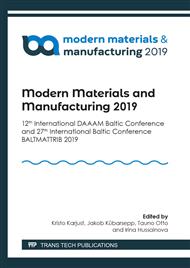[1]
Gu, D. (2015). Laser Additive Manufacturing of High-Performance Materials. New York Dordrecht London: Springer.
Google Scholar
[2]
D T Pham, R. S. (1998). A comparison of rapid prototyping Technologies. Int J Mach Tools Manuf 38 (10-11) , 1257-1287.
Google Scholar
[3]
Ian Gibson, D. R. (2010). Additive Manufacturing Technologies 3D Printing, Rapid Prototyping and Direct Digital Manufacturing. New York Dordrecht London: Springer Science & Business Media.
DOI: 10.1007/978-1-4939-2113-3
Google Scholar
[4]
Information on http://www.stratasys.com.
Google Scholar
[5]
Information on https://www.tth.com/3d-printing/fdm-prototyping.
Google Scholar
[6]
Yuan Jin, Y. H. (2016). Process Planning for the Fuse Deposition Modeling of Ankle Foot Orthoses. 18th CIRP Conference on Electro Physical and Chemical Machining, 760-765, ELSEVIER.
DOI: 10.1016/j.procir.2016.02.315
Google Scholar
[7]
Choi S, C. H. (2006). A topological hierarchy-based approach to toolpath planning for multi material layered manufacturing. Computer Aided Design, 38:143-56.
DOI: 10.1016/j.cad.2005.08.005
Google Scholar
[8]
Jin Y, H. Y. (2014). Optimization of tool-path generation for material extrusion-based additive manufacturing technology. Additive Manufacturing, 1:32-47.
DOI: 10.1016/j.addma.2014.08.004
Google Scholar
[9]
Information on https://www.3dhubs.com.
Google Scholar
[10]
Umair Ali Rana, D. S. (2015). Development of design methodology for biomimetic adaptive infills for additive manufacturing. Rawalpindi: CEME, NUST.
Google Scholar
[11]
Hodgson, G. (2013). Slic3r User Manual. Free Software Folks.
Google Scholar
[12]
Information on https://ultimaker.com/en/resources/20416-infill.
Google Scholar
[13]
Yong Huang, M. L. (2015). Additive Manufacturing: Current State, Future Potential, Gaps and Needs, and Recommendations. Journal of Manufacturing Science and Engineering.
DOI: 10.1115/1.4028725
Google Scholar
[14]
Yuan Jin, Y. H. (2017). A non-retraction path planning approach for extrusion based additive manufacturing. Robotics and Computer Integrated Manufacturing 48, 132-44.
DOI: 10.1016/j.rcim.2017.03.008
Google Scholar
[15]
Hao L., R. D. (2010). Enhancing the sustainability of additive manufacturing. International Conference on Responsive Manufacturing-Green Manufacturing, 390-5.
DOI: 10.1049/cp.2010.0462
Google Scholar
[16]
Yuan Jin, J. D. (2017). Optimization of process planning for reducing material consumption in Additive Manufacturing. Journal of Manufacturing Systems 44, 65–78.
DOI: 10.1016/j.jmsy.2017.05.003
Google Scholar
[17]
Yuan Jin, Y. H. (2017). A novel path planning methodology for extrusion based additive manufacturing of thin walled parts. International Journal of Computer Integrated Manufacturing.
DOI: 10.1080/0951192x.2017.1307526
Google Scholar
[18]
F. Roger, (2015). Optimal design of fused deposition modeling structure using comsol Multiphysics. Proceedings of the 2015 COMSOL conference, Grenoble.
Google Scholar



